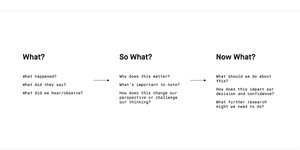
1, #91 - What? So What? Now What?

high-value advice, in general), is about insight .
Insight requires context, nuance, and judgment.
Insight requires context, nuance, and judgment.
- What are you trying to accomplish?
- What's your timeframe?
- What other constraints should I be aware of?
- Do you have more time to invest than money, or more money to invest than time?
- What do you love?
- What do you hate?
- What will you say you'll do?
- What will
Twenty-Two Pages of Replies ...
It’s the process of synthesis, which requires a smart human or two to look at the whole and decide what really matters, what needs to be kept, what needs to be removed, and what two or more pieces can simply be combined into a new whole.
Chris Brogan • The Impact Equation: Are You Making Things Happen or Just Making Noise?
Achieving strategic clarity is hard. It takes asking tough questions about tradeoffs, deep concentration to get to the very essence of the issues and real courage to cut off competing priorities. It is worth the effort because with real clarity, people, teams and organizations can fully mobilize, break through to the next level and achieve... See more